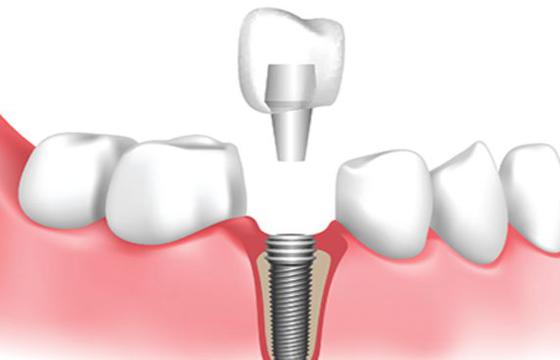
Private Nanodent Oral and Dental Health Center
- Akkuyu - Konyaaltı/Antalya
- 9 km from center
- 22 km to Airport
- Özel Nanodent Ağız Ve Diş Sağlığı Merkezi
Single dental implants provide various advantages over alternative tooth replacement solutions like bridges or dentures, including increased aesthetics, functionality, and longevity. Additionally, single dental implants help to minimize bone loss in the jaw and give long-term stability for surrounding teeth. This is a guide of what is an implant and why someone needs them?

A single dental implant is a dental treatment in which a single prosthetic tooth root is surgically inserted into the jawbone to replace a lost tooth. This prosthetic tooth root, usually made of titanium, acts as a solid basis for a replacement tooth or crown.
Consultation and Planning (one visit), if you are a suitable candidate, Implant Placement(same visit),
Then about 3 months pass for healing period. Placement of the Abutment(one visit), implant has bonded and abutment is attached to the implant. After Impressions and Fabrication of the Crown, Placement of the Crown(one visit).
So, a single dental implant can take anywhere from 3 visits and three to six months or longer.
Single dental implants are primarily classified into two groups based on their materials and structure,
Endosteal implants are the most popular type of dental implant used to replace a single tooth. These implants are surgically inserted directly into the jawbone. Endosteal implants are often made of titanium, a biocompatible material that integrates well with bone throughout the healing process. After the implant has fused with the jawbone, a custom-made crown is fitted to replace the lost tooth.
Subperiosteal implants are less common and are used when a patient does not have enough bone height or width to support standard endosteal implants. Subperiosteal implants are held in place by a metal framework that is implanted beneath the gum tissue but above the jawbone, rather of being inserted into it. Subperiosteal implants are commonly used when bone grafting is not possible or when the patient is unable to undergo standard implant surgery.
Endosteal implants are usually the best option for replacing a single lost tooth because of its high success rate, durability, and ability to give long-term stability.
Single dental implants generally consist of biocompatible materials that the body tolerates and successfully integrates with the jawbone. The most commonly utilized materials for single dental implants are,
Titanium is the most popular material for dental implants. It is highly biocompatible, which means it is well accepted by the body and rarely causes adverse responses or rejection. Titanium implants have the unusual capacity to osseointegrate, which means they can fuse with the surrounding bone tissue over time, forming a solid foundation for the replacement tooth or crown.
Titanium Alloys, in addition to pure titanium, dental implants can be manufactured from titanium alloys, which are mixtures of titanium and additional metals like aluminum, vanadium, or nickel. Titanium alloys can have better mechanical qualities and corrosion resistance than pure titanium, making them appropriate for specific therapeutic applications.
Zirconia dental implants are constructed of zirconium dioxide, a ceramic substance that is used instead of titanium. Zirconia implants are white and tooth-colored, making them a more visually appealing alternative for patients with weak or translucent gum tissue. While zirconia implants do not osseointegrate as well as titanium implants, they can nonetheless deliver dependable long-term results in carefully selected instances.
Both titanium and zirconia dental implants offer benefits and may be appropriate for different clinical settings and patient preferences.
Single dental implant treatment consists of numerous stages, including consultation, implant implantation, recovery and restoration. Here's a step-by-step breakdown of what usually happens during treatment,
First session, the procedure starts with an initial consultation with a dentist or oral surgeon. During this session, the dentist will assess your oral health, discuss your treatment objectives, and decide whether you are a good candidate for a dental implant.
Treatment Planning, if you are a candidate for a dental implant, the following step is treatment planning. This may include obtaining X-rays, 3D scans and impressions of your teeth and jaws to determine bone density, discover anatomical features and plan the best implant location.
Implant insertion is normally performed with local anesthetic to ensure your comfort. During surgery, the dentist or oral surgeon will make an incision in the gum tissue to reveal the underlying jawbone. They will then drill a small hole in the bone and delicately insert the implant into the prepared spot. The gum tissue is then sutured together around the implant.
Healing and Osseointegration, after the implant is placed, a process known as osseointegration occurs, in which the implant fused with the surrounding bone tissue. This process normally takes many months and is critical to maintaining the implant's durability and effectiveness.
Abutment Placement, once osseointegration has happened and the implant has become solidly integrated with the jawbone, a small connector known as an abutment is placed to it. The abutment protrudes through the gum line and acts as a connection point for the final repair.
Fabrication of the Restoration, after the abutment is installed, impressions of your teeth are taken to create a custom-made restoration, such as a crown, bridge or denture, based on your treatment plan and requirements.
Placement of the Final Restoration, once the restoration procedure is complete, it is secured to the abutment with dental cement or screws. The dentist will check that the restoration fits correctly, operates well and mixes in with your original teeth.
Follow-Up consultations: After the treatment is completed, you will have follow-up consultations with your dentist to check the healing process, confirm the implant's stability and address any concerns or issues that may emerge.
Thus, the procedure of single dental implant therapy includes careful planning, competent surgical placement and suitable post-operative care to ensure successful outcomes and restore function and aesthetics of the smile.
There are many options for single dental implant treatment, depending on the patient's unique necessitate oral health state, and preferences. Some typical options are,
Fixed Dental Bridge, is a prosthetic device that replaces one or several lost teeth. A typical fixed bridge is made up of one or more artificial teeth (pontics) that are anchored to nearby natural teeth, known as abutments. The pontic is suspended between the abutments, "bridging" the gap left by the missing tooth.
Resin-Bonded Bridge (Maryland Bridge), also known as a Maryland bridge, is a more conservative option to typical fixed bridges. Maryland bridges are made up of an artificial tooth (pontic) secured in place by metal or porcelain wings that are connected to surrounding natural teeth with dental cement.
A complete denture is a removable dental appliance that replaces all of the teeth in either one or both dental arches. Dentures are constructed of acrylic or a combination of acrylic and metal and are intended to rest on the gums and underlying bone tissue.
Resin-Bonded Retainer, in situations when a single missing tooth is located in the front of the mouth, a resin-bonded retainer may be an alternative treatment option. This conservative procedure entails gluing a metal or porcelain wing to the rear of the surrounding teeth and attaching the artificial tooth to the wing.
It is critical to visit with a knowledgeable dentist or prosthodontist to explore your options and choose the best treatment for your unique needs.
When implants properly cared for and maintained, they will last for many years and in some circumstances, a lifetime. Several factors can influence the lifetime of a dental implant.
Bone Quality, the success and lifetime of a dental implant are determined by the quality and quantity of the jawbone in which it is put.
Good oral hygiene, practices such as regular brushing, flossing and dental check-ups are critical for the health of the implant and surrounding gum tissue.
Smoking has been linked to an increased risk of implant failure and complications because it impairs the body's ability to recover and increases the possibility of infection.
Dental Habits, like teeth grinding (bruxism) can put undue strain on the implant, leading to implant failure or difficulties over time.
As a whole, while single dental implants are intended to be a robust and long-lasting treatment for replacing lost teeth, their durability is determined by a variety of factors, including patient characteristics, oral health practices and implant insertion quality.



*The treatment pages provided on this platform are intended for informational purposes only and do not constitute medical or dental advice, diagnosis, or treatment recommendations. The information presented on these pages is not a substitute for professional medical or dental advice from qualified healthcare providers.
*By accessing and using the treatment pages on this platform, you acknowledge and agree to the terms of this disclaimer. If you do not agree with these terms, please refrain from using the treatment pages.